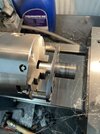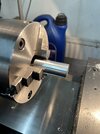Hi
I have been spending some time rebuilding my Rapide clutch and am pretty happy. Just got a quick question on tolerance:
I've replaced the clutch sprocket PD20, its two bushes PD22 & PD24, and also the shoe carrier C3. Now that it's assembled, the sprocket and drum assembly has 40 thou of end float on the carrier spigot which feels excessive. Any advice whether it is? When the clutch is engaged, this amount of play might help the primary chain run true, but at the cost of clutch pushrod travel?
(Hopefully video posts ok)
Thanks
Milo
I have been spending some time rebuilding my Rapide clutch and am pretty happy. Just got a quick question on tolerance:
I've replaced the clutch sprocket PD20, its two bushes PD22 & PD24, and also the shoe carrier C3. Now that it's assembled, the sprocket and drum assembly has 40 thou of end float on the carrier spigot which feels excessive. Any advice whether it is? When the clutch is engaged, this amount of play might help the primary chain run true, but at the cost of clutch pushrod travel?
(Hopefully video posts ok)
Thanks
Milo


